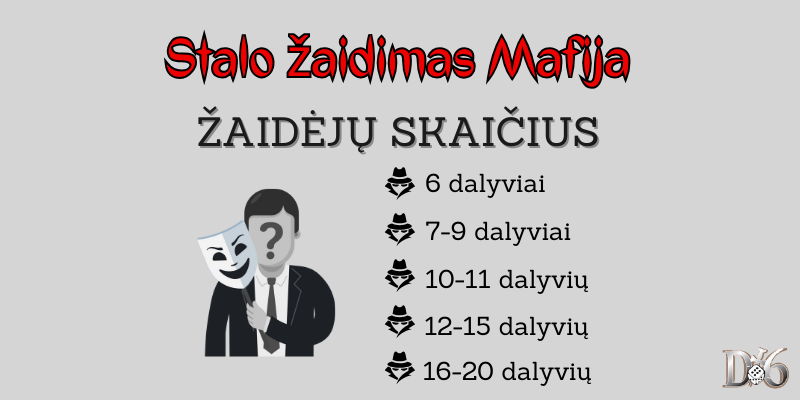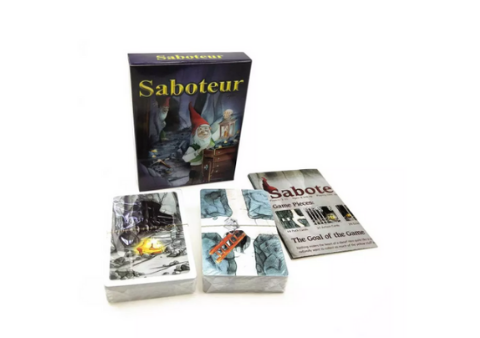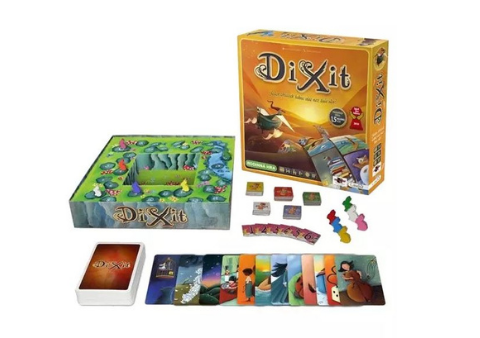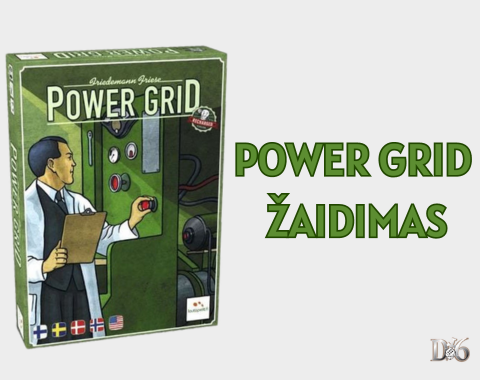Mafia is a game where players have to discover who are the real members of the Mafia and who are just innocent townspeople. It is a very fun and addictive game, as you need to be able to lie, analyse and communicate with other players.
In this article, we will discuss the main features of the game - the type of game, the number of players available, the length of the game, the difficulty, the age limits of the players, the story and other aspects of the game.
Key facts
Designed for: 1986
Type: Strategic, psychological, party
Number of players: 6-20
Duration: 30-60 minutes
Complexity: Medium
Age of players: from 12 years
Mafia game - a quick overview
✔️ The aim of the game
The main objective of Mafia is to survive and defeat the other side. The goal of the Mafia members is to "kill" all the inhabitants or to reach the same number of people as the population of the town. The goal of the latter is to identify and "hang" the mafia members.
✔️ Game type
The role-playing game Mafia is a strategic, psychological board game that's perfect for parties. Strategy comes into play when you need to plan your actions and decisions to stay alive and "kill" your enemies at the same time.

✔️ Duration of the game
The length of the game depends on the number of players, the speed and the length of the discussions. On average, a game lasts about 30-60 minutes, but the game can go on for a long time due to different interpretations of the game or discussions.
✔️ Game difficulty
The game is not very complex in terms of rules, but it requires a lot of attention, logical thinking and intuition. In addition, each game is different and unpredictable because it depends on the behaviour of the players and the decisions they make.
✔️ Age of players
There are no strict age limits for the game, but it is recommended that the youngest players are aged 12 or over. This is only a guideline as the game can be quite traumatic for younger children.
The game also requires the ability to lie and guess who is lying. This task may be too difficult for younger players.
Number of players
To start a team a board game, you need at least 6 people: 1 host and 5 players (2 mafia members and 3 residents). However, the game can be adapted to a larger or smaller number of people. Usually between 6 and 20 people play.

Combination of characters is possible for a larger number of participants:
- 7-9 participants: 2-4 townspeople, 2 mafia representatives and 3 special characters (a doctor, a loose girl, a detective).
- 10-11 participants: 4-5 townspeople, 3 mafia, 3 special characters (a doctor, a loose girl, a detective).
- 12-15 participants: 5-8 townspeople, 4 mafia representatives, 3 special characters (a doctor, a loose girl, a detective).
- 16 participants and more: The Mafia is one third of the cast, the townspeople are the rest, and the special characters (a doctor, a loose girl, a detective) are chosen at the player's discretion.
Mafia game - the pros

✅ Easily adaptable to different situations and needs by changing the number of players, the roles, the length of the game and the rules.
✅ Develops social skills - a great way to meet new people or spend time with friends, as it encourages communication, cooperation and competition.
✅ Psychological insight - includes psychological elements such as understanding facial expressions, body language and verbal cues.
✅ Stimulates learning by developing critical thinking, reasoning, language and creative skills.
Mafia board game - cons

❌ Complex rules - Newcomers may find the rules and process confusing and may take some time to understand how the game works.
❌ Duration of the game - depending on the number of players and the length of the debate, the game may drag on.
❌ Early end of the game - when a player is removed from the game at the start, they are no longer able to actively participate, which can be frustrating as they may have to wait a long time for the game to finish.
What is in the game kit?
The game requires cards with the roles of the players and instructions from the card host. The cards can be prepared in advance or created by the players themselves. It is also recommended to use special masks made for the game.
Each participant has to get one card with their role: mafia member, townsman or special character (e.g. commissioner, free girl (prostitute), anarchist, sergeant or doctor). The presenter must have cards with the rules and the course of the game.
Preparing for the game
The first step is to choose a host for the game. This should be the person who will run the game and announce the final results. The host has no role in the game and does not contribute to the action of the game.
A set of cards should then be prepared according to the number of players and their preferences.
In most cases, at least two Mafia cards are needed, along with the cards of the rest of the population. It is highly recommended to add special character cards to make the game more interesting or challenging.
To start the game, the host must shuffle all the cards and deal one to each player. After receiving it, and being familiar with his/her role, the player must hide the card safely from the other players.
Roles
At the start of the game, all players must be randomly assigned to one of the following roles:
✔️ Mafia: Mafia members are trying to stay under the radar and eliminate the town's inhabitants.
✔️ Residents of the town: its inhabitants try to expose and "hang" members of the Mafia.
✔️ Special characters: they add extra intrigue to the game.

When the game is played by 6 to 20 players or even more, the players are divided into several groups: the mafia, the townspeople and, to spice up the game, the special role-playing players.
- Mafioso: A key member of the mafia who, at night, consults with other mafia members on his side of the game about who to "kill", and during the day, tries to pass himself off as an innocent townsman. The mafiosi know each other and communicate in secret.
- Detective or Commissioner: A town representative who can choose one player at night to find out if he is a member of the Mafia or not. The detective has to be careful not to reveal his identity because the mafia might kill him.
- Doctor: a representative of the town's inhabitants who can choose one player at night and save him from death if he is chosen by the mafia and "killed". The doctor cannot save the same player twice in a row.
- Free-spirited girl: a representative of the townspeople's side, who can select one player at night and block his ability. If a prostitute chooses a mafioso, he cannot vote for the victim, and if he chooses a detective, a doctor or any other special character, he cannot use his ability.
- Sergeant: a representative from the town side, who has an extra one vote during the day when it comes to voting on who will be "repeated". The Sergeant must show his/her card to all players before the game starts.
- Anarchists: a neutral character who can choose one player to kill at night. The Anarchist is the game's schemer, who can choose and kill a member of the mafia. In addition he wins the game only when he is the only one left "alive".
How to play Mafia?
The point of the game is to reveal the roles of the other players, while at the same time not betraying your own role to others.
Mafia rules are important to ensure that the game runs smoothly and fairly.
The process looks like this:
The Mafia host starts the game by saying the following words:
"Night has come. Everyone is asleep (at which point all players must close their eyes, or - highly recommended - put on a special mask), only the Mafia are awake (they open their eyes or take off their mask)".
The mafia then selects a victim, points to one player and "kills" the victim.
Apart from the mafia, only the presenter needs to see it.
Mafia members then close their eyes or put on masks.
The presenter says:
"The Commissioner wakes up" (the Commissioner takes off his mask or opens his eyes).
The commissioner (or detective) guesses which of the players might be a member of the mafia, and the presenter nods as to whether or not the commissioner has guessed. If he is right, when all the players are up, he can try to persuade the others to vote for one or the other person, thus adding a certain intrigue to the game.
After the Commissioner has fallen asleep (wearing a mask), the presenter says:
"The doctor wakes up" (the doctor takes off his mask or opens his eyes).
He chooses a man he wants to cure from Mafia bullets. If his choice points to a man who has just been "killed" by the Mafia, then the victim is saved.
After all this, the day comes, everyone turns up (takes off their masks) and the presenter tells them which person has been "killed". The player must remain passive for the rest of the game.
But if the doctor guesses, the presenter says the victim was saved, but does not reveal his identity.
Afterwards, a discussion starts among all the players as to who could be a real member of the Mafia. Everyone offers their guesses and defends themselves if attacked. After all the discussion, everyone takes a vote.
The person with the most upvotes drops out and reveals their role in the game. Then the night comes again and the presenter tells the same story again.
The game ends when either the Mafia kill everyone or the townspeople vote the Mafia out.
Mafia game - key milestones
The board game Mafia has several main stages that all players must complete during the game. These phases include night, day, voting, results and the ongoing process. Let's look at them in a little more detail.

Night
During the night phase, the mafia decides which inhabitant of the town they want to "kill". During this time, the special role players play their roles, the mafiosi choosing the victim and the commissioner "investigating" the events and thus influencing and intriguing the other players to make certain decisions.
The Day
During the day, players discuss, vote and try to identify which players are members of the Mafia. This is usually a heated debate, with all sorts of arguments being debated as people try to figure out who are the real inhabitants of the town and who are members of the mafia.
Vote
After the debate, the players vote on which player should be removed. This can be based on players' speeches, suspicions or just a random choice. It may be heavily influenced by the Commissioner's advice or, conversely, by adding more confusion to the game.
Announcement of results
When a player is removed, his role in the game is known to everyone. If the removed player is a member of the mafia, the town's population reduces the mafia's chances of winning. However, if the player was a real resident of the town, the mafia members' chances of winning the game are increased.
Continuation phase
After the results are announced, the game is repeated from the beginning and a new night round begins.
Players continue their attempts to expose the mafia and protect themselves from elimination.
Scoring
- At the end of the game, points can be scored based on which team won and how many members are still alive.
- If the Mafia wins, each Mafia member gets 2 points.
- If the townspeople win, each townspeople gets 1 point.
- If there is a draw, nobody gets any points.
- If a player who has a special role wins, they get an extra point for fulfilling their role (e.g. a detective gets a point for every mafia member correctly exposed, a doctor gets a point for every player saved, etc.).
- Points can be used to motivate the game or to summarise certain phases.
The history and uniqueness of Mafia
The game was developed in 1986 by Dmitri Davidov, who was a psychology student. He wanted to test his hypothesis about how people behave in groups and their ability to detect liars.
According to the rules he created, in the initial phase of the game, 10 people were allowed to participate: 2 mafia members, 7 residents and 1 game host, who had to be a neutral player who ran the game and announced the final results.
The game quickly became popular not only in students' dormitories or at parties, but also at camps.
After graduating, Davidov began teaching Eastern European students at the university, and the game soon spread In Europeand later became popular all over the world.
In China, the game is used to treat gambling addiction, and in Japan it is included in the jury training programme to help identify lies.
Summary
Mafia is a very popular and well-known board game that creates a wonderful atmosphere and a great mood, making it the perfect choice for parties. It is suitable for young and old alike, in large or small group gatherings. If you like intrigue, mystery and a shot of adrenaline, this is the game for you!
This game is a great way to spend time with your friends, to test your persuasive emotions, charm and deductions skills. It's a really challenging game that requires excellent people skills and strong emotional intuition. This is what gives the game its uniqueness and allows each player to try to implement their own strategy.
How many people can play this game❓
According to the game rules, a minimum of 6 people are required: 1 host and 5 players (2 mafia members and 3 residents), but up to 20 can participate.
What is the duration of the game❓
The duration depends on the number of players, but on average a game lasts about 30-60 minutes.
The game was invented by psychology student Dmitry Davidov.
What is the recommended age of players❓
It is recommended that the youngest players are 12 years old.
What are the stages in Mafia❓
The main stages of the game are day, night, voting, announcement of the results, and the ongoing process of starting all over again.





